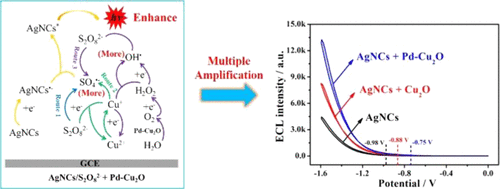当前位置:
X-MOL 学术
›
Anal. Chem.
›
论文详情
Our official English website, www.x-mol.net, welcomes your
feedback! (Note: you will need to create a separate account there.)
Peptide-Based Electrochemiluminescence Biosensors Using Silver Nanoclusters as Signal Probes and Pd-Cu2O Hybrid Nanoconcaves as Coreactant Promoters for Immunoassays
Analytical Chemistry ( IF 6.7 ) Pub Date : 2021-09-15 , DOI: 10.1021/acs.analchem.1c03002 Xianzhen Song 1 , Tingting Wu 1 , Chuannan Luo 1 , Lu Zhao 1 , Xiang Ren 1 , Yong Zhang 1 , Qin Wei 1
Analytical Chemistry ( IF 6.7 ) Pub Date : 2021-09-15 , DOI: 10.1021/acs.analchem.1c03002 Xianzhen Song 1 , Tingting Wu 1 , Chuannan Luo 1 , Lu Zhao 1 , Xiang Ren 1 , Yong Zhang 1 , Qin Wei 1
Affiliation

|
Metal nanoclusters (NCs) possess high light stability and biocompatibility because of their unique quantum size effect, which has gradually become a new type of electrochemiluminescence (ECL) nanomaterial for immunoassays. However, the luminescence efficiency of metal NCs is too low to meet the needs of trace analysis, which limits its application. Herein, Ag NCs served as signal probes and Pd-Cu2O hybrid nanoconcaves served as coreaction promoters, developing a highly efficient peptide-based biosensor for neuron-specific enolase (NSE) detection. Utilizing the reversible cycle of Cu+/Cu2+ and the reduction characteristics of Pd NPs, Pd-Cu2O greatly accelerates the reduction of S2O82–. Meanwhile, Pd-Cu2O has good hydrogen evolution activity, which promotes the generation of oxygen by improving the redox efficiency of the overall reaction, thus increasing the yield of active intermediates (OH•) to promote the reduction of S2O82–. Specially, this is an effective attempt to use the hydrogen evolution reaction (HER) to accelerate the ECL emission of the S2O82– system. In addition, a short peptide ligand (NARKFYKGC, NFC) was developed to implement the targeted immobilization of antibodies, which can specifically bind to the Fc fragment of antibodies, thereby avoiding the occupation of the antigen binding site (Fab fragment). The introduction of NFC not only improves the binding efficiency of antibodies but also protects its bioactivity, thus significantly improving the sensitivity of the biosensor. Based on these strategies, the proposed biosensor provides a new perspective for the applications of metal NCs in ECL systems.
中文翻译:

使用银纳米团簇作为信号探针和 Pd-Cu2O 杂化纳米凹面作为免疫测定的共反应物促进剂的基于肽的电化学发光生物传感器
金属纳米团簇(NCs)由于其独特的量子尺寸效应而具有较高的光稳定性和生物相容性,逐渐成为一种用于免疫测定的新型电化学发光(ECL)纳米材料。然而,金属NCs的发光效率太低,无法满足痕量分析的需要,限制了其应用。在此,Ag NCs 作为信号探针,Pd-Cu 2 O 杂化纳米凹面作为共作用促进剂,开发了一种高效的基于肽的生物传感器,用于神经元特异性烯醇化酶 (NSE) 检测。利用Cu + /Cu 2+的可逆循环和Pd NPs的还原特性,Pd-Cu 2 O大大加速了S 2 O 8的还原2-。同时,Pd-Cu 2 O具有良好的析氢活性,通过提高整个反应的氧化还原效率促进氧的生成,从而提高活性中间体(OH •)的产率,促进S 2 O 8 2的还原- . 特别是,这是利用析氢反应(HER)加速S 2 O 8 2–的ECL发射的有效尝试。系统。此外,还开发了一种短肽配体(NARKFYKGC,NFC)实现抗体的靶向固定,可以特异性结合抗体的Fc片段,从而避免占用抗原结合位点(Fab片段)。NFC的引入不仅提高了抗体的结合效率,而且保护了其生物活性,从而显着提高了生物传感器的灵敏度。基于这些策略,所提出的生物传感器为金属 NCs 在 ECL 系统中的应用提供了新的视角。
更新日期:2021-09-28
中文翻译:

使用银纳米团簇作为信号探针和 Pd-Cu2O 杂化纳米凹面作为免疫测定的共反应物促进剂的基于肽的电化学发光生物传感器
金属纳米团簇(NCs)由于其独特的量子尺寸效应而具有较高的光稳定性和生物相容性,逐渐成为一种用于免疫测定的新型电化学发光(ECL)纳米材料。然而,金属NCs的发光效率太低,无法满足痕量分析的需要,限制了其应用。在此,Ag NCs 作为信号探针,Pd-Cu 2 O 杂化纳米凹面作为共作用促进剂,开发了一种高效的基于肽的生物传感器,用于神经元特异性烯醇化酶 (NSE) 检测。利用Cu + /Cu 2+的可逆循环和Pd NPs的还原特性,Pd-Cu 2 O大大加速了S 2 O 8的还原2-。同时,Pd-Cu 2 O具有良好的析氢活性,通过提高整个反应的氧化还原效率促进氧的生成,从而提高活性中间体(OH •)的产率,促进S 2 O 8 2的还原- . 特别是,这是利用析氢反应(HER)加速S 2 O 8 2–的ECL发射的有效尝试。系统。此外,还开发了一种短肽配体(NARKFYKGC,NFC)实现抗体的靶向固定,可以特异性结合抗体的Fc片段,从而避免占用抗原结合位点(Fab片段)。NFC的引入不仅提高了抗体的结合效率,而且保护了其生物活性,从而显着提高了生物传感器的灵敏度。基于这些策略,所提出的生物传感器为金属 NCs 在 ECL 系统中的应用提供了新的视角。











































 京公网安备 11010802027423号
京公网安备 11010802027423号